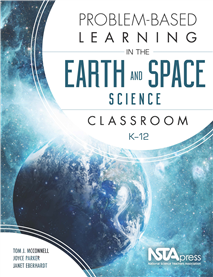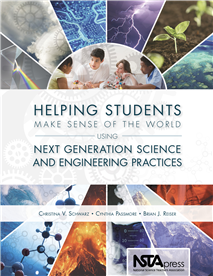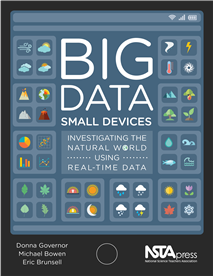All Book Chapters
Book Chapter
In this lesson, students try to explain what happens in the solar eclipse, and why a person in one location can see a solar eclipse while a person in another place cannot. Key words and concepts covered are solar eclipse. Crosscutting concepts explor...
Book Chapter
In this lesson, two friends living across the country from each other see a lunar eclipse at the same time and wonder how it is possible. Key words and concepts covered are lunar eclipse. Crosscutting concepts explored are patterns, scale, proportion...
Book Chapter
In this lesson, a brother and sister learn that Venus is visible as either a morning star or an evening star at different times of the year, and they try to explain the pattern of movement of Venus in the sky. Key words and concepts covered are movem...
Book Chapter
Problem-Based Learning in the Earth and Space Science Classroom, K–12 (Book Sample)
There is a lot to like about this text, and I truly believe that teachers will both like it and use it. Implementing PBL is difficult for teachers, and few curriculum guides are available to support their efforts. This book fills that gap by providin...
Book Chapter
Moving Beyond “Knowing” About Science to Making Sense of the World
This chapter introduces the book and explores the fundamental shifts implied by engaging students in science and engineering practices. We have many opportunities to make significant and lasting change in the ways we teach science at the K-12 level. ...
Book Chapter
The Framework, the NGSS, and the Practices of Science
This chapter explicates the rationale for focusing on science and engineering practices and traces the development of this idea from earlier notions of inquiry in science. In going from the Framework to the Next Generation Science Standards (NGSS), t...
Book Chapter
Toward More Equitable Learning in Science
This chapter examines some important questions about equity in the science classroom. It explores how a focus on practices is in line with goals we have to make science accessible, intelligible, and meaningful for all learners. The chapter shares and...
Book Chapter
The Role of Practices in Scientific Literacy
This chapter takes up the question of our broader societal goals for science literacy and explains the connections between these goals and the focus on engaging students in science and engineering practices. All of the activities featured afford stud...
Book Chapter
Asking questions might seem like a practice that is already in widespread use in today’s science classrooms. But the practice of “Asking Questions” as envisioned in the Next Generation Science Standards (NGSS) is not at all common. In this chap...
Book Chapter
Planning and Carrying Out Investigations
In this chapter, we share how different parts of investigations can be designed so that they work together and help students answer questions. In particular, we describe several ways to design effective investigations using examples from elementary c...
Book Chapter
Analyzing and Interpreting Data
In this chapter, to highlight the development of this practice across K–12, a series of classroom examples are presented of analyzing and interpreting data. Each example is followed by a commentary that highlights the salient features of the exampl...
Book Chapter
Using Mathematics and Computational Thinking
Using mathematics and computational thinking practice is all about finding precise ways to describe the patterns and processes that make up scientific and engineered systems. This chapter discusses three interrelated issues for getting started in you...
Book Chapter
In this chapter, we examine student engagement in the science practice of constructing explanations, which is a key practice of science and lies at the core of what the discipline is about. Engaging in explanation construction helps students see how ...
Book Chapter
Engaging in Argument From Evidence
In this chapter, we offer three vignettes of the practice of engaging in argument from evidence. These examples highlight the ways in which the components of engaging in argument from evidence—supported claims, evaluation and critique, and reconcil...
Book Chapter
Obtaining, Evaluating, and Communicating Information
In this chapter, the details of the practice of obtaining, evaluating, and communicating information are outlined and examples and resources provided related to implementing the practice. We hope that this information will help teachers and others le...
Book Chapter
The first part of this chapter explains the importance of the two practices that include elements designed to address the different goals and outcomes of engineering. The latter part of the chapter, shares a classroom case that illustrates the entir...
Book Chapter
This chapter is about fostering what we call academically productive talk in science classrooms to support students’ engagement with the eight science and engineering practices. We first introduce a picture of the most common varieties of classroom...
Book Chapter
Throughout the chapters, we have provided many vivid images of students who are learning science in meaningful ways. In this chapter, we provide guidance about how these goals can be accomplished, using two examples. From the two units we’ve descri...
Book Chapter
This chapter concludes our discussion of the science and engineering practices with a summary of the big ideas from the book and a few strategies. We revisit some important ideas about science and engineering practices we hope you have developed, wea...
Book Chapter
Big Data, Small Devices: Investigating the Natural World Using Real-Time Data (Book Sample)
Now your students can transform their mobile phones and tablets into tools for learning about everything from weather to water quality. Big Data, Small Devices shows you how. This book is designed for Earth and environmental science teachers who want...
Book Chapter
In this lesson, students will explore the relationship between tropospheric ozone and temperature and how human populations affect ozone levels. Disciplinary core ideas covered are weather and climate and human impacts on Earth systems. Tips for scal...
Book Chapter
In this lesson, students will use mean (average) temperature data to determine changes in surface temperature over time in different areas of Earth. Disciplinary core ideas covered are Earth’s systems and weather and climate. Tips for scaling down,...
Book Chapter
In this lesson, students will use a National Oceanic and Atmospheric Administration (NOAA) database to identify extreme weather events throughout the United States in different locations or over time. Disciplinary core ideas covered are Earth’s sys...
Book Chapter
In this lesson, students will use weather data to create a current weather map by drawing station models for multiple locations. Disciplinary core ideas covered are Earth materials and systems and weather and climate. Tips for scaling down, scaling u...
Book Chapter
In this lesson, students will develop and analyze meteograms for select cities to construct a 24-hour history for a specific location. Disciplinary core ideas covered are Earth materials and systems and weather and climate. Tips for scaling down, sca...
Book Chapter
In this lesson, students will use flight take-off and landing patterns to better understand wind. Disciplinary core ideas covered are Earth materials and systems and weather and climate. Tips for scaling down, scaling up, and extending the lesson are...
Book Chapter
In this lesson, students will come to understand the range and frequency of behaviors in which animals can engage, and how those might be affected by factors such as weather conditions or time. Disciplinary core ideas covered are natural resources an...
Book Chapter
In this lesson, students will compare population dynamics in emerging and developed nations, including how those populations use natural resources. Disciplinary core ideas covered are Earth and human activity and natural resources. Tips for scaling d...
Book Chapter
In this lesson, students will explore long-term trends in land use using data from the U.S. Department of Agriculture (USDA). Disciplinary core ideas covered are natural resources and human impacts on Earth systems. Tips for scaling down, scaling up,...
Book Chapter
In this lesson, students will determine whether there is a correlation between drought and wildfires using data from two states. Disciplinary core ideas covered are the roles of water in Earth’s surface processes and natural hazards. Tips for scali...
Book Chapter
In this lesson, students will explore the relationship between earthquake depth and tectonic plate boundaries. Disciplinary core ideas covered are Earth materials and systems and plate tectonics and large-scale system interactions. Tips for scaling d...
Book Chapter
In this lesson, students will learn about the radiation levels in their state and county and compare them to levels in two other states. Teaching about radon addresses a safety issue and relates to content knowledge about radiation and geology. Disci...
Book Chapter
In this lesson, students will develop a model that illustrates that the tectonic plates are moving in different directions on Earth’s surface. Disciplinary core ideas covered are Earth materials and systems and plate tectonics and large-scale syste...
Book Chapter
In this lesson, students will explore volcanoes in the United States and relate them to tectonic plates in Earth’s crust. Disciplinary core ideas covered are Earth materials and systems and plate tectonics and large-scale system interactions. Tips ...
Book Chapter
In this lesson, students will use buoy data to determine the relationship between wind speed and wave height. Disciplinary core ideas covered are Earth materials and systems and the roles of water in Earth’s surface processes. Tips for scaling down...
Book Chapter
Dissolved Oxygen and Water Quality
In this lesson, students will explore the relationship between water temperature and dissolved oxygen. Disciplinary core ideas covered are natural resources and Earth’s systems. Tips for scaling down, scaling up, and extending the lesson are includ...
Book Chapter
In this lesson, students will explore how oceans mitigate climate at midlatitudes. Disciplinary core ideas covered are the roles of water in Earth’s surface processes and weather and climate. Tips for scaling down, scaling up, and extending the les...
Book Chapter
In this lesson, students will explore the relationship between the ocean tides and the cycles of the Moon. Disciplinary core ideas covered are the roles of water in Earth’s surface processes and Earth materials and systems. Tips for scaling down, s...
Book Chapter
In this lesson, students will see how photoperiods change during a year, at locations at different latitudes. Disciplinary core ideas covered are Earth and the solar system and Earth’s systems. Tips for scaling down, scaling up, and extending the l...
Book Chapter
In this lesson, students will illustrate and compare the patterns of day and night across the globe during different seasons. Disciplinary core ideas covered are Earth and the solar system and Earth’s systems. Tips for scaling down, scaling up, and...





